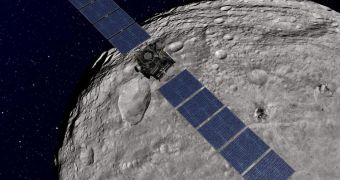At a meeting held by the European Geosciences Union in Vienna, Austria, on April 25, experts provided an in-depth view of the contribution that the NASA Dawn orbiter brought to understanding Vesta, the largest asteroid in our solar system.
The object lies in the Inner Asteroid Belt (IAB), between the orbits of Mars and Jupiter, and is widely believed to be a protoplanet. This means that it once had the potential to turn into an Earth-like rocky planet, but that something happened to prevent that.
Dawn was developed in order to investigate both Vesta, and the IAB dwarf planet Ceres, in detail. It achieved orbital insertion around the asteroid in mid-July 2011, and was originally scheduled to study the object for about a year. Its mission has been recently extended by more than a month.
Since then, the spacecraft has been collecting data on Vesta's mineral composition, temperature swings, internal structure, surface makeup and so on. It successively occupied four different orbits around the space rock, taking it from 420 to 130 miles (680 to 210 kilometers) above its surface.
Experts hope that studying this miniature world will reveal more details about the early solar system, and about how its current components evolved. If things had gone a bit differently, both Ceres and Vesta may have become planets in their own right.
One of the things that Dawn revealed is that some of the material on the asteroid was once molten beneath its surface, indicating that the body displayed geological activity many eons ago. The orbiter was also able to reveal the existence of impact-fused rocks called breccias.
“Dawn now enables us to study the variety of rock mixtures making up Vesta's surface in great detail. The images suggest an amazing variety of processes that paint Vesta's surface,” Münster University Dawn participating scientist, Harald Hiesinger, explains.
One of the most important discoveries made at Vesta is that the surface of the asteroid appears to be in a constant process of renewing. “We are closing in on the giant asteroid's secrets,” investigator Carol Raymond explains.
“After more than nine months at Vesta, Dawn's suite of instruments has enabled us to peel back the layers of mystery that have surrounded this giant asteroid since humankind first saw it as just a bright spot in the night sky,” the NASA Jet Propulsion Laboratory Dawn deputy principal investigator adds.
After it leaves Vesta, this August, the orbiter will head out to meet Ceres, where it will also conduct a series of similar studies. It is currently scheduled to begin observing the dwarf planet in February 2015, and complete its primary mission 6 months later.

 14 DAY TRIAL //
14 DAY TRIAL //